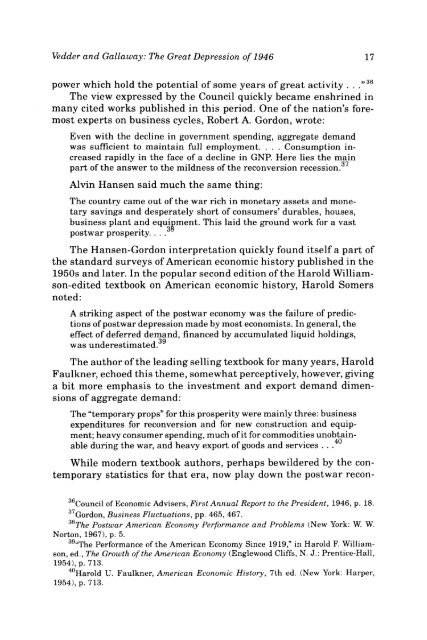Review of Austrian Economics - The Ludwig von Mises Institute
Review of Austrian Economics - The Ludwig von Mises Institute
Review of Austrian Economics - The Ludwig von Mises Institute
You also want an ePaper? Increase the reach of your titles
YUMPU automatically turns print PDFs into web optimized ePapers that Google loves.
Vedder and Gallaway: <strong>The</strong> Great Depression <strong>of</strong> 1946 17<br />
power which hold the potential <strong>of</strong> some years <strong>of</strong> great activity . . ," 36<br />
<strong>The</strong> view expressed by the Council quickly became enshrined in<br />
many cited works published in this period. One <strong>of</strong> the nation's foremost<br />
experts on business cycles, Robert A. Gordon, wrote:<br />
Even with the decline in government spending, aggregate demand<br />
was sufficient to maintain full employment. . . . Consumption increased<br />
rapidly in the face <strong>of</strong> a decline in GNP. Here lies the main<br />
part <strong>of</strong> the answer to the mildness <strong>of</strong> the reconversion recession.<br />
Alvin Hansen said much the same thing:<br />
<strong>The</strong> country came out <strong>of</strong> the war rich in monetary assets and monetary<br />
savings and desperately short <strong>of</strong> consumers' durables, houses,<br />
business plant and equipment. This laid the ground work for a vast<br />
postwar prosperity. . . .<br />
<strong>The</strong> Hansen-Gordon interpretation quickly found itself a part <strong>of</strong><br />
the standard surveys <strong>of</strong> American economic history published in the<br />
1950s and later. In the popular second edition <strong>of</strong> the Harold Williamson-edited<br />
textbook on American economic history, Harold Somers<br />
noted:<br />
A striking aspect <strong>of</strong> the postwar economy was the failure <strong>of</strong> predictions<br />
<strong>of</strong> postwar depression made by most economists. In general, the<br />
effect <strong>of</strong> deferred demand, financed by accumulated liquid holdings,<br />
was underestimated.<br />
<strong>The</strong> author <strong>of</strong> the leading selling textbook for many years, Harold<br />
Faulkner, echoed this theme, somewhat perceptively, however, giving<br />
a bit more emphasis to the investment and export demand dimensions<br />
<strong>of</strong> aggregate demand:<br />
<strong>The</strong> "temporary props" for this prosperity were mainly three: business<br />
expenditures for reconversion and for new construction and equipment;<br />
heavy consumer spending, much <strong>of</strong> it for commodities unobtainable<br />
during the war, and heavy export <strong>of</strong> goods and services . . .<br />
While modern textbook authors, perhaps bewildered by the contemporary<br />
statistics for that era, now play down the postwar recon-<br />
36 Council <strong>of</strong> Economic Advisers, First Annual Report to the President, 1946, p. 18.<br />
37 Gordon, Business Fluctuations, pp. 465, 467.<br />
38 <strong>The</strong> Postwar American Economy Performance and Problems (New York: W. W.<br />
Norton, 1967), p. 5.<br />
39 "<strong>The</strong> Performance <strong>of</strong> the American Economy Since 1919," in Harold F. Williamson,<br />
ed., <strong>The</strong> Growth <strong>of</strong> the American Economy (Englewood Cliffs, N. J.: Prentice-Hall,<br />
1954), p. 713.<br />
40 Harold U. Faulkner, American Economic History, 7th ed. (New York: Harper,<br />
1954), p. 713.

















